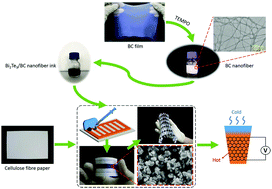A honeycomb-like paper-based thermoelectric generator based on a Bi2Te3/bacterial cellulose nanofiber coating
Abstract
The intrinsic properties of paper, such as its light weight, flexibility, foldability, portability and degradability, have led to increasing interest in fabricating flexible energy storage devices and power supply devices on paper-based substrates. Hereby, a robust honeycomb-like thermoelectric generator (TEG) inspired by the origami and kirigami techniques was established in the present study. A thermoelectric ink with the properties of high electrical conductivity and low thermal conductivity was formulated by Bi2Te3 and bacterial cellulose (BC). The formulated ink was printed on a paper surface using a facile processing method. The manufactured paper was further folded and bonded to fabricate a honeycomb-like TEG. This honeycomb-like paper-based TEG exhibited 96 p–n junctions, achieving a maximum voltage and output power of ∼70.5 mV and ∼596 nW, respectively, at a 55 K temperature difference. Moreover, the honeycomb structure was able to withstand a large number of bending and stretching cycles while maintaining its pristine structure. This unique honeycomb structure thus provides a new strategy for future development of paper-based TEGs.

- This article is part of the themed collection: Editor’s Choice: Thermoelectric nanostructures


 Please wait while we load your content...
Please wait while we load your content...